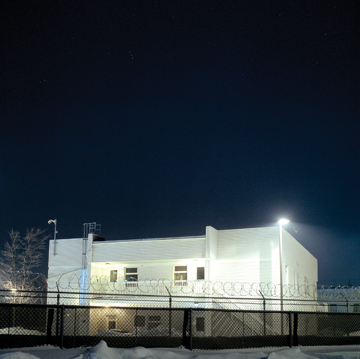[Fall 2008]
Donald Browne Galery, Montreal
April 19–May 24, 2008
In her new exhibition at Galerie Donald Browne, Emmanuel Léonard made her consummately subversive voice heard from the outset. Her singular art of juxtaposition, theatricality, gathered “evidence,” and narrative layering once again adumbrated an environmental volume that radically exceeded the sum of its parts.
The quadriptych retablo revealed Léonard at her most reduced. Only four photographs were on display, but they were radiant – and riveting. They pinned us to the walls as we pivoted between images of a caged white wolf, a bald eagle, and two stark photographs of the facade of a women’s prison. We experienced a frisson of enclosure and the interrogation chair – innocent bystanders caught, as it were, between a proverbial rock and a hard place. As we moved among these images, we sensed an interlacing of sombre meanings and ominous signs that were disturbing, unsettling, even overwhelming.
Léonard based this meta-narrative on the Biblical story of the Annunciation. But you need not have been raised Catholic here in Quebec to appreciate the powerful dark undertow of this exceptionally moody installation. Conceptual strength and imagistic power, hallmarks of all of Léonard’s works, marked this contemporary retelling of the Mystery. In the Bible, The Annunciation, narrated in the book of Luke, Chapter 1, verses 26–38, describes how the Angel Gabriel is sent by God to deliver his message to the Virgin Mary that she will bear a son:
The angel went to her and said, “Greetings, you who are highly favoured! The Lord is with you.” Mary was greatly troubled at his words and wondered what kind of greeting this might be. But the angel said to her, “Do not be afraid, Mary, you have found favour with God. You will be with child and give birth to a son, and you are to give him the name Jesus. He will be great and will be called the Son of the Most High. The Lord God will give him the throne of his father David, and he will reign over the house of Jacob forever; his kingdom will never end.” “How will this be,” Mary asked the angel, “since I am a virgin?” The angel answered, “The Holy Spirit will come upon you, and the power of the Most High will overshadow you. So the holy one to be born will be called the Son of God.”
Léonard makes telling analogies between her images and central elements of the Annunciation narrative. The bald eagle is an inspired surrogate for the archangel Gabriel, at once stern and noble, if not ennobling. The Joliette Prison is the only federal penitentiary in Quebec for women serving sentences of longer than two years. One of the two prison structures pictured is a mobile home situated just inside the prison fence, where an inmate on good behaviour is allowed to spend time with her children. The wolf inhabits what could pass for a manger (used by Mary as a cradle or bed for Jesus), and this caught-in-the-headlights creature is a surrogate for Mary, of course, frozen in the heavenly glare of the divine light. Apparently, the French word for female wolf derives from the original lupa, designating a prostitute. The entire installation is leavened with generous helpings of Léonard’s razor-sharp dark, mordant wit.
The religious subtext of the work references Léonard’s Catholic upbringing and seems at first to distinguish it from her earlier series, Une sale affaire (2007), exhibited at Optica in 2007. But in fact, the two series have much in common: conceptual rigour, acerbic bite, and unusual clarity. In Une sale affaire, Léonard attempted a critical examination of the allegedly “unemotional” realm of police photography. (She even included in that work an enlarged photocopy of evidence that she acquired while visiting the Quebec evidence archives.) While a picture that appears on page one of the Quebec tabloids is meant to move us viscerally, police photographs are intended to perform as evidence without emotional trappings. Léonard effectively wedded and transgressed both domains. She is a savant at constructed theatricality – and bending images to her will – in narrative structures that seduce even as they disturb. Her Gabriel/bald eagle on-the-prowl and her Mary/caged-wolf-in-waiting play upon and undermine the tenets of amateur animal photography just as ably as Une sale affaire did to explode the inherent codes of police photography.
Notably, she still follows the edict from the Royal Canadian Mounted Police crime scene photography course: “Always squeeze the shutter release as you do the trigger on your gun.” Her art marries conceptualism and photojournalism, and in this exhibition she has once again essayed a mood-riven and seductive noir-ish fiction; only this time she has captured Biblical orthodoxy squarely in her crosshairs.
As I meandered through the room in which the images were installed, I found myself repeating endlessly, like an mantra: “The Holy Spirit will come upon you, and the power of the Most High will overshadow you…” from the aforementioned Gospel according to Saint Luke. Emmanuelle Léonard’s work stakes that kind of claim upon you.
James D. Campbell is a writer on art and independent curator based in Montreal. The author of over 100 books and catalogues on contemporary art and artists, he contributes frequently to visual arts publications across Canada.

